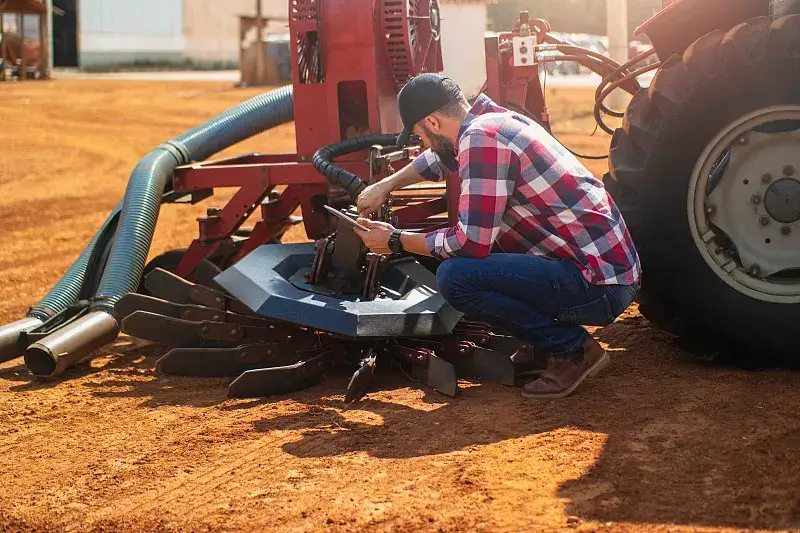Farm equipment is indispensable in modern agriculture, directly influencing productivity and efficiency. From tractors and combines to plows and seeders, these machines enable farmers to manage vast expanses of land and perform essential tasks with precision. However, without proper maintenance, even the most advanced equipment can suffer from reduced performance, unexpected breakdowns, and costly repairs.
Maintaining farm equipment is not just about avoiding breakdowns—it’s a strategic approach to extending the lifespan of your machinery, enhancing operational efficiency, and ultimately saving on costs. In this guide, we’ll delve into ten essential maintenance practices, supported by data and insights, to help you keep your farm equipment in optimal condition.
Farm equipment comes in various forms, each designed for specific tasks:
- Tractors:
These versatile machines are used for tilling, planting, and hauling. According to a study by the American Society of Agricultural and Biological Engineers (ASABE), tractors make up 40% of the total farm equipment used in the U.S. Common issues include engine failures and hydraulic system malfunctions.
- Harvesters:
Essential for collecting crops, harvesters can encounter problems with cutting blades and engine performance. The National Agricultural Statistics Service (NASS) reports that harvesters account for approximately 25% of the machinery used during harvest seasons.
- Plows and Cultivators:
Used for soil preparation, these tools often experience wear on their blades and parts. Regular maintenance helps prevent reduced efficiency and crop yield losses.
Understanding the specific functions and common issues associated with each type of equipment allows for tailored maintenance strategies that address the unique needs of each machine.
Contents
- 1 10 Essential Ways to Maintain Your Farm Equipment
- 1.1 1.Regular Inspection
- 1.2 2.Keep Equipment Clean
- 1.3 3.Lubrication is Key
- 1.4 4.Maintain Fluid Levels
- 1.5 5.Tire Care and Maintenance
- 1.6 6.Sharpen and Replace Worn Parts
- 1.7 7.Battery Maintenance
- 1.8 8.Protect Equipment from the Elements
- 1.9 9.Follow Manufacturer’s Maintenance Schedule
- 1.10 10.Train Operators on Proper Use and Maintenance
- 2 Preventive Maintenance
- 3 Troubleshooting Common Problems
- 4 Tools and Resources for Maintenance
- 5 Professional Services and Support
- 6 Conclusion
10 Essential Ways to Maintain Your Farm Equipment
1.Regular Inspection
Regular inspections are vital for early detection of potential issues. According to data from the Farm Equipment Manufacturers Association (FEMA), daily inspections can prevent up to 30% of equipment breakdowns. Key areas to inspect include:
- Tires: Check for proper inflation and signs of wear. Under-inflated tires can reduce fuel efficiency and increase the risk of accidents.
- Fluid Levels: Regularly monitor oil, coolant, and fuel levels to ensure they are within the recommended ranges.
- Belts and Hoses: Inspect for cracks or fraying, which can lead to failures if not addressed promptly.
- Filters: Check and replace air, oil, and fuel filters to maintain engine efficiency.

2.Keep Equipment Clean
Dirt and debris can negatively impact equipment performance. According to a study by the Agricultural Equipment Research Group, a clean machine operates 15% more efficiently than a dirty one. Effective cleaning techniques include:
- Washing: Use water and mild detergent to clean the exterior and remove dirt.
- Drying: Ensure that all parts are completely dry to prevent rust and corrosion.
- Special Attention: Focus on areas prone to accumulation, such as radiators and air filters.
3.Lubrication is Key
Proper lubrication reduces friction and wear. The Equipment Maintenance Institute reports that regular lubrication can extend the lifespan of moving parts by up to 25%. Key points to consider:
- Lubricants: Use the recommended types of oil and grease for different components.
- Schedule: Follow the manufacturer’s lubrication schedule to ensure all critical parts are adequately lubricated.
- Application: Apply lubricants evenly and avoid over-lubrication, which can attract dust and debris.
4.Maintain Fluid Levels
Maintaining proper fluid levels is crucial for equipment operation. According to data from the Machinery Maintenance Institute, proper fluid levels can improve engine performance by up to 20%. Important fluids to monitor include:
- Engine Oil: Check and top off as needed to ensure smooth engine operation.
- Hydraulic Fluid: Ensure levels are adequate for optimal hydraulic system performance.
- Coolant: Keep coolant levels within the recommended range to prevent overheating.
- Fuel: Regularly check fuel levels to avoid running out during operation.
5.Tire Care and Maintenance
Tires play a critical role in equipment performance and safety. Research by the Agricultural Equipment Advisory Board indicates that proper tire maintenance can enhance traction and reduce fuel consumption by up to 10%. Key practices include:
- Pressure Checks: Regularly measure and adjust tire pressure according to manufacturer specifications.
- Inspection: Look for signs of wear and damage, such as cracks or uneven tread.
- Rotation and Replacement: Rotate tires periodically and replace them when tread wear exceeds safety limits.
6.Sharpen and Replace Worn Parts
Maintaining sharp blades and well-functioning parts is essential for effective operation. The Equipment Performance Association notes that sharp blades can improve cutting efficiency by up to 30%. Key practices include:
- Sharpening: Regularly sharpen blades to ensure efficient cutting and reduce strain on the engine.
- Replacement: Replace worn or damaged parts promptly to avoid further damage and maintain performance.
7.Battery Maintenance
The battery is crucial for starting equipment and powering various systems. According to the Battery Maintenance Council, proper battery care can extend its life by up to 50%. Important practices include:
- Cleaning Terminals: Remove corrosion from battery terminals to ensure good electrical contact.
- Checking Charge Levels: Regularly monitor charge levels and recharge as necessary.
- Maintenance Tips: Keep the battery clean and secure to prevent vibration-related damage.
8.Protect Equipment from the Elements
Exposure to environmental factors can damage farm equipment. Data from the Farm Equipment Protection Group indicates that proper storage can reduce weather-related damage by up to 40%. Key practices include:
- Sheltered Storage: Store equipment in a garage or shed to protect it from rain, snow, and UV rays.
- Use of Covers: Apply protective covers to shield equipment from dust and moisture.
- Seasonal Preparation: Winterize equipment and prepare it for different seasonal conditions to prevent damage.
9.Follow Manufacturer’s Maintenance Schedule
Adhering to the manufacturer’s maintenance schedule is critical for equipment longevity. Research by the Equipment Maintenance Council shows that following recommended maintenance intervals can reduce the risk of major repairs by up to 30%. Key practices include:
- Scheduled Maintenance: Perform regular checks and services as outlined in the equipment manual.
- Documentation: Keep detailed records of all maintenance activities to track equipment health and ensure compliance.
10.Train Operators on Proper Use and Maintenance
Educating operators on correct usage and maintenance practices is essential for preventing misuse and ensuring effective equipment care. According to the Agricultural Training Institute, well-trained operators can reduce maintenance issues by up to 20%. Key practices include:
- Training Programs: Implement training sessions to educate operators on equipment operation and maintenance.
- Promote Care: Encourage a culture of accountability and proper equipment care among all users.

Preventive Maintenance
Preventive maintenance involves routine upkeep to prevent equipment failures. The American Agricultural Machinery Association reports that effective preventive maintenance can reduce downtime by up to 40%. Benefits include:
- Scheduled Plans: Develop and follow a maintenance schedule based on manufacturer recommendations.
- Avoiding Major Repairs: Regular maintenance helps identify issues early, preventing costly major repairs.
- Improved Efficiency: Well-maintained equipment operates more efficiently, leading to better overall performance.
Troubleshooting Common Problems
Identifying and addressing common equipment issues is crucial for maintaining operational efficiency. According to the Farm Machinery Diagnostics Association, timely troubleshooting can resolve up to 70% of equipment problems without professional help. Key steps include:
- Diagnosis: Observe symptoms such as unusual noises, leaks, or performance issues.
- Basic Troubleshooting: Check common problem areas, such as fluid levels, belts, and filters.
- Seeking Professional Help: For complex issues, consult a professional to avoid exacerbating the problem.
Tools and Resources for Maintenance
Having the right tools and resources is essential for effective maintenance. According to the Machinery Maintenance Resource Center, proper tools can enhance maintenance efficiency by up to 25%. Essential tools include:
- Basic Tools: Wrenches, screwdrivers, grease guns, and diagnostic equipment.
- Resources: Manufacturer’s manuals, online guides, and maintenance apps provide valuable information and guidance.
- Utilization Tips: Use resources to stay informed about best practices and troubleshoot issues effectively.
Professional Services and Support
While many maintenance tasks can be performed in-house, professional services are sometimes necessary. The Farm Equipment Service Association estimates that professional maintenance can prevent up to 50% of potential equipment failures. Key considerations include:
- Choosing a Service Provider: Select a provider with good reviews, relevant experience, and transparent pricing.
- Service Records: Maintain detailed records of all professional services and repairs for future reference.
Conclusion
Maintaining farm equipment is essential for ensuring its longevity, efficiency, and reliability. By implementing these ten key maintenance practices—ranging from regular inspections and cleaning to proper lubrication and battery care—you can significantly enhance the performance and lifespan of your machinery. Regular maintenance not only helps prevent costly repairs but also ensures that your equipment operates at peak efficiency, contributing to the success of your farming operations.

